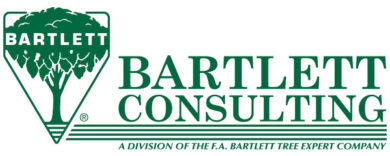3 Things You Can Do with a Tree Growth Regulator…Besides Regulate Growth
By Brandon Gallagher Watson
On a hot day in late summer, an observant city forester noticed something different between two groups of linden trees planted along opposite sides of the street. The lindens growing along one side were showing the typical symptoms of late-season drought: yellowish-green colored leaves, scorched edges, and an overall “wilty” appearance. Along the opposite side of the street, the linden trees were growing under utility lines and generally looked pretty good. Although the leaves appeared slightly smaller, they were still green — darker green, in fact, than would be expected — and they had no scorched edges. Despite the same difficult growing conditions as the trees across the way, why were trees on this side of street thriving while the others suffered?
Curious, the forester looked into the history of the site and learned the trees growing under the power lines had been treated with the tree growth regulator paclobutrazol. The product has been widely used in the industry for decades to minimize the rate at which pruned trees would grow back into utility lines. While this would account for the smaller leaves he observed, it didn’t seem to account for these tree’s ability to better withstand the stressful growing environment of this streetscape. This serendipitous observation would eventually lead to scores of research trials over several years that would show tree growth regulators were doing much more in trees than just reducing growth.
The study and use of plant growth regulators began with agricultural crops in the 1930s. Broadly defined, a growth regulator is simply any chemical used to alter the growth of a plant or a part of the plant. While one could technically argue water and nutrients are chemicals that alter the growth of plants, growth regulators more specifically work with plant hormones to achieve their result. There are growth regulators that can stimulate accelerated growth by promoting the formation of auxins, growth regulators that can decrease fruit production by affecting the formation of cytokinins, and growth regulators that can ripen fruit by increasing ethylene. The growth regulator mentioned earlier, paclobutrazol, decreases vegetative growth by inhibiting the formation of gibberellins, which are the group of hormones responsible for cell elongation. When applied to, say, a tree under a power line that had just been trimmed, these treatments can reduce the length of regrowth the tree would naturally respond with. The tree still produces the same number of cells, only those cells do not stretch out as far. Over a three-year period, treated trees grow at a rate 40 to 70 percent less than the growth rate of the untreated trees. So, how does a product that is known to reduce cell elongation result in trees being seemingly more drought and stress tolerant?
That answer would come though research aimed at better understanding the secondary effects growth regulation was having on trees. Trees produce their energy by photosynthesis, which takes place in the leaves. Thus, it should follow that smaller leaves should result in lower photosynthesis rate and less energy. However, research was showing trees treated with gibberellic acid inhibitors were producing the same amount of energy as untreated trees. As is turns out, gibberellic acid is made from some of the same base compounds as chlorophyll. Thus, reducing gibberellic acid formation results in an increase in chlorophyll production. This accounts for the trees photosynthesizing at the same rate despite smaller leaves. It also accounts for the darker green appearance trees treated with paclobutrazol display. Which leads us to our first “thing you can do with a growth regulator besides regulate growth”: greener leaves.
One of the uses our tree care company has found for growth regulators, such as paclobutrazol (Cambistat) is for greening up trees suffering from mild chlorosis. Chlorosis is a condition in which the plant cannot properly manufacture chlorophyll. It can be related to micro-nutrient deficiencies, poor soil habitats, or other factors that can affect a plant’s ability to thrive. Although growth regulators have no nutrient value, we have observed trees go from a pale green color to a richer green simply through an application of paclobutrazol. Chlorosis resulting from nutrient deficiencies can be corrected in two ways: provide the plant with the nutrient (such as when we inject soluble iron into a tree suffering from a lack of iron) or by improving the tree’s ability to obtain nutrients from the soil. It appears that growth regulation is doing two things that can help with chlorosis management: increase chlorophyll production resulting from the decrease in gibberellic acid production, as well as help the tree better mine nutrients from the soil. This leads to our second “thing you can do with a growth regulator besides regulate growth”: improve root systems.
As mentioned, trees treated with growth regulators produce an equal amount of energy as untreated trees, but where they put that energy differs. Think of energy like funds in your bank accounts, the more you allocate to one account, the less you have to allocate to another. With plants, the less energy they are spending on vegetative growth, the more they have to allocate to other resources such as defense compounds, reproductive structures such as flowers, carbohydrate storage, and fibrous root growth. This last one, root growth, has myriad uses in tree care. Arborists will often employ these treatments on trees that will be enduring root damage during an upcoming construction project as a means of pre-stress conditioning. They are also utilized after root loss or damage has occurred to encourage the tree to form new roots. It has been shown they can help trees adapt to poor soil conditions better. However, it should be noted that these treatments will not help roots grow in compacted, cement-like soils. Success rates go up significantly when these treatments are combined with physical remediation such as Air-spade work or vertical mulching. Basically, if you can improve the soil conditions for roots, a growth regulator can encourage roots to grow into it.
The forester who noticed growth-regulated trees were looking better come late summer stumbled upon our third “thing you can do with a growth regulator besides regulate growth”: increase drought tolerance. As mentioned in previous articles on drought and trees, plants respond to drought by utilizing abcisic acid to close their stomata and reduce water loss. It turns out — just like we saw with chlorophyll — that gibberellic acid is made from some of the same base compounds as other plant hormones such as abcisic acid. So, by reducing the amount of gibberellic acid the tree is producing, we are increasing the amount of abcisic acid. This slower-growing tree will be putting more energy into root production than shoot production, and with the increased abcisic acid, it can be more responsive to urban tree stress conditions. These treatments also trigger changes in leaf morphology, such as a thicker waxy cuticle layer and increased trichromes — the leaf hairs that help protect the stomata. Although nothing will help a tree through drought times better than water, growth regulators represent one of a small number of tools arborists have to help trees along when it’s dry.
Fifty years ago, when these products were first being developed, no one could have envisioned all the ways they would be used to benefit trees. Growth regulators are a good example of where astute observation, lab and field research, and innovative arborists intersect to forward the science and practice of tree care. New research is leading to new uses for growth regulators with managing insects and diseases, as well as extending the service life of urban trees. It’s a good reminder to stay observant of your management actions and to always be curious about the results you are seeing, because you never know where arboriculture’s next breakthrough will come from.
Brandon M. Gallagher Watson is director of communications at Rainbow Treecare Scientific Advancements, and is an ISA Certified Arborist (#MN-4086A).


